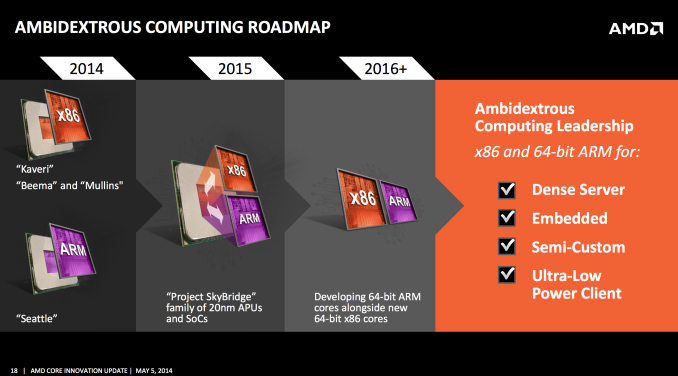AMD is also working on a new 64-bit x86 Core
by Anand Lal Shimpi on May 5, 2014 1:16 PM EST
Jim Keller joined Mark Papermaster on stage at AMD's Core Innovation Update press conference and added a few more details to AMD's K12 announcement. Keller stressed AMD's expertise in building high frequency cores, as well as marrying the strengths of AMD's big cores with those of its low power cores. The resulting K12 core is a 64-bit ARM design, but Jim Keller also revealed that his team is working on a corresponding 64-bit x86 core.
The x86 counterpart doesn't have a publicly known name at this point, but it is a new design built from the ground up.










112 Comments
View All Comments
MartinT - Monday, May 5, 2014 - link
I'm telling you that AMD has never shown signs of catching up with Intel in x86 performance since the release of Conroe/Merom/Woodcrest almost eight years ago.Hence my scepticism at the OP's prediction that they will be caught up in "2-3 years."
Alexey291 - Tuesday, May 6, 2014 - link
and yet AMD hasn't had a "Mid-end" (ahem) CPU for about 6 or so years. They were all strictly "below 200usd" mark.Gizmosis350k - Wednesday, May 7, 2014 - link
If all he does is buy $1k chips and shit on AMD, he must be living life in the fast laneThe_Assimilator - Monday, May 5, 2014 - link
"AMD will reach performance parity with Intel sometime within the next 2 - 3 years"That's what AMD fans have been saying since Conroe. It ain't happened since then, it ain't gonna happen in the future. Intel is ahead, they know it, and after the P4 fiasco they won't ever give up their lead in the x86 race.
Flunk - Monday, May 5, 2014 - link
That's been said before, back in the Socket 7 era. Then AMD caught up with the Athlon and pulled ahead with the Athlon XP and stayed competitive up until the Core 2 was released. You can't write off AMD yet. Intel has been dragging their heels on CPU performance since Sandy Bridge so there is a potential opening there.Gizmosis350k - Wednesday, May 21, 2014 - link
The problem is that Moore's law is dead. If AMD gets in shape now they can reach right up there but the architects and more importantly Global Foundries is where the real problem liesbji - Monday, May 5, 2014 - link
As a response to your comment, and to many of the comments above yours: the difference is that since Sandy Bridge, the speed at which Intel is moving forward on x86 performance has slowed, the first time in the history of x86 that this has happened. So the game is different now. Intel is moving ahead more slowly, and it will cost AMD less to catch up now.As Flunk below mentions, AMD actually already did catch up and surpass Intel once, when Intel stumbled. Now, in 2014 (and since 2011-ish, really), Intel hasn't stumbled so much as they've simply hit a performance improvement wall. Now that Intel isn't moving forward so fast, AMD can catch up.
cmdrdredd - Monday, May 5, 2014 - link
You think Intel has slowed progress on performance because they can't progress faster. Truth is they don't have to so they stall on purpose to milk consumers. I thought it was obvious myself.bji - Tuesday, May 6, 2014 - link
I think you're wrong. The desktop market is stagnating, on the verge of shrinking if it isn't already. x86 CPUs have been more than fast enough for casual uses for at least 6 years now. They've been more than fast enough for moderately stressful work for more than 3 years now. There are very few workloads, used by very few people, that can't be satisfactorily handled by a $200 CPU from three years ago. Finally, the lowest hanging fruit have already been picked over and over again in the quest for improving x86 performance. The node shrinks have just about hit an impossible, or at least very diffficult to breach, wall.All of this means that it is now prohibitively expensive to increase x86 performance substantially. Doing so demands more money than the market has to offer Intel for doing so. Sure, increases will happen, but only at a pace that can be achieved with lesser investment as demanded by lesser market interest in x86.
Lower power, on the other hand - that is an area where the advances are easier to make, at least for now, and consumer demands are high, given that more x86 CPUs are going into notebooks now than desktops.
Intel *can't* progress any faster, not while investing in R & D that is actually expected to have payoff. But AMD? AMD still has lower hanging fruit to pick. They can get down to the same process node as Intel, piggybacking off of demand from other segments of the industry that provide the dollars necessary to update fabs to tech competitive with Intel. They can exploit new ideas in CPU architecture (new to them, probably old to Intel) to bring their IPC up to par with Intel.
It will happen, not because AMD will magically become better at competing with Intel, but because Intel will hit the wall first (and is already hitting it form a performance increase perspective) and AMD will have the benefit of the trail already being blazed for them, and having to spend less money to get to that wall. It costs more to be the frontrunner than to follow the frontrunner. And so once the frontrunner can no longer run faster, the one trailing it will catch up.
Carleh - Tuesday, May 6, 2014 - link
And AMD is right to diversify its portfolio with ARM cpus, so it can tap both markets at once, minimizing risk.